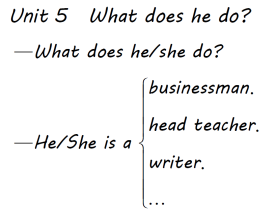人教pep六上英语 Unit 5 The first period第一课时教案
Unit 5 What does he do?
![]()
教材分析 | 本单元学习的主题是人物职业和生活情况。教学内容主要是通过家长日Oliver和Sarah谈论各自父母工作的情景以及Mike和Xiao Yu在回家路上谈自己家人工作和生活的场景来展开的。教学重点是能听、说、读、写核心句型“—What does he/she do? —He/ She is…”“—Where does he/she work? —He/ She works…”“—How does he/she go to work? —He/ She goes to work…”;能听、说、读、写单词和词组:factory worker, postman, businessman, police officer, fisherman, scientist, pilot, coach |
教学目标 | 知识与能力目标: ·能够听、说、读、写句型“—What does he do? —He is a businessman.”“—Where does he work? —He works at sea.”“—How does he go to work? —He goes to work by bike.” · 能够在情景中运用句型“—What does he/she do? —He/ She is…”“—Where does he/she work? —He /She works…”“—How does he/she go to work? —He/ She goes to work…”谈论人物的职业和生活情况 ·能够在图片的帮助下正确理解并按照正确的意群及语音、语调朗读关于爱好及职业的语篇, 能运用本单元所学核心句型口头描述自己的爱好和喜欢的职业,同时能仿照范例完成信息表 ·能够听、说、读、写单词和词组:factory worker, postman, businessman, police officer, fisherman, scientist, pilot, coach ·能够正确使用上述单词和词组谈论和描述人物的职业和生活情况 ·知道逗号是英语句子中停顿的标志 情感态度、文化意识、学习策略目标: ·了解橙色多用于各国紧急救援的衣服和设备上,如:救生衣、救生艇、消防员衣服、工程抢险车等 ·能够从不同视角认识职业,明白能从事某些职业应具备的条件,构思自己的职业梦想 ·能够通过看图捕捉关键信息,并根据提示做出听前预测 ·能够通读文段获取主旨大意,并能据此选择合适的标题 |
课时安排 | 第一课时: Part A Let’s try & Let’s talk 第二课时: Part A Let’s learn & Listen, match and say 第三课时: Part B Let’s try & Let’s talk 第四课时: Part B Let’s learn & Write and discuss 第五课时: Part B Read and write 第六课时: Part B Let’s check & Let’s wrap it up & Part C Story time |
The first period(第一课时)
Part A Let’s try & Let’s talk ![]()
▶教学内容与目标
课时教学内容 | 课时教学目标 |
Let’s try | ·能够读懂题目要求,学会听前预测听力的重点内容 ·能够运用基本听力技巧完成Let’s try板块的听力任务 |
Let’s talk | ·能够通过观察、谈论Let’s talk板块的图片,在图片、PPT和老师的帮助下理解对话大意,并回答对话后面的问题 ·通过听录音,学会按照正确的意群及语音、语调朗读对话,并能在小组中进行角色表演 ·能够在情景中运用句型“—What does he/she do?—He/ She is…”谈论人物的职业 ·能够在情景中运用第三人称单数的特殊疑问句 ·在语境中借助图片等帮助理解“country, head teacher”的意思,并能正确发音 |
▶教学重点
能够在情景中运用句型“—What does he/ she do?—He/ She is…”谈论人物的职业。
▶教学难点
能够在情景中运用第三人称单数的特殊疑问句。
▶教学准备
PPT课件、课文录音、视频和教学卡片等。
 ▶教学过程
▶教学过程
1
Step 1: Warm-up & Lead-in
1. Greetings.
2. Revision—Brainstorm.
Show some pictures of different jobs on the PPT. Help students review the words of the jobs.(课件出示:一些不同职业的图片及其职业词汇,如:driver, doctor, cook, farmer, basketball player, dancer, singer 等,最后在中间呈现“jobs”)
3. Lead-in.
T: My father is a teacher. My mother is a nurse. What about your father and mother?
Ss: My father is a/an…
T: In this unit, we’re going to talk about “jobs”. We’ll learn how to ask and answer about jobs.
Write down the topic “What does he do?” on the blackboard.
T: Today is Parents’ Day. Our friends’ parents will come to school to meet the teachers. Who will come? Can you guess?
Ss: …
Step 2: Presentation
 1. Listen and circle.
1. Listen and circle.
(1) Show the part of “Let’s try” to students. Students read the question by themselves.(课件出示:教材P48 Let’s try板块的内容)
T: Listen to the recording. Please pay attention to the bold words. Who will come?
(2) Play the recording.(课件出示:教材P48 Let’s try板块的音频)
Students listen to the recording and try to answer the question.
(3) Play the recording again and ask students to circle the answers in the book.(出示课件)Then check the answers.
 T: What does Sarah’s father do? Is he a doctor, a teacher or a taxi driver?
T: What does Sarah’s father do? Is he a doctor, a teacher or a taxi driver?
Ss: He’s a doctor.
2. Look and predict.
Show the pictures of “Let’s talk” to students. Let students look at the pictures carefully. Ask some questions to lead them to predict the main idea of the dialogue.(课件出示:教材P48 Let’s talk板块的图片)
Questions: ①Who are they?/ ②Who are they talking about?/ ③Is it Parents’ Day today? Who will come? Oliver’s father or his mother, or both?/…
 3. Watch and answer.
3. Watch and answer.
Show the questions on the PPT. Let students watch the cartoon and try to answer the questions.(课件出示:教材P47 Let’s talk板块的视频及下列问题)
Q1: Who are they talking about?(They are talking about Oliver’s father and mother.)
Q2: Who will come?(Oliver’s mother will come.)
T: Yes. Oliver’s mother will come today. And how about Oliver’s father?
 S1: Oliver’s father can’t come.
S1: Oliver’s father can’t come.
T: Why?
S2: Because Oliver’s father is in Australia now.
4. Read and answer.
Students read the dialogue and try to answer the questions.(课件出示:下列问题)
Q3: What does Oliver’s father do?
Q4: What does Oliver’s mother do?
T: What does Oliver’s father do?
S1: He’s a businessman.
T: Yes. He’s a businessman. He sales things. He often goes to other countries. Maybe Japan, the USA, …
Help students understand the words “businessman, country”. Teach the words. Students learn to read.
T: What does Oliver’s mother do?
S2: She’s a teacher.
T: Yes! She’s a head teacher. In our school, Mr…/Mrs…is our head teacher.
Teach the phrase “head teacher”. Students learn to read.
T: Do you want to be a head teacher? (Ask several students. Help them to answer.)
S3: Yes. I want to be a head teacher. / No, I want to be a/an…
 T: What does Oliver’s father do? What does Oliver’s mother do? How does Sarah ask? How does Oliver answer?
T: What does Oliver’s father do? What does Oliver’s mother do? How does Sarah ask? How does Oliver answer?
Write down the sentence structures “—What does he/she do? —He/ She is…” on the blackboard.
Students practice in pairs.
5. Read and act.
(1)Students read after the recording. Pay attention to the pronunciation and the intonation.(出示课件)
(2)Let students practice the dialogue in groups. Then act out.
(3)Make a new dialogue.
Step 3: Practice
1. Choose and say.
Show some word cards(writer, cleaner, taxi driver, singer, dancer, football player)to students. Students read the words one by one.
 Then let some students choose one card each time. And ask them to use the sentences to describe it. For example, “I like writing stories for children.” The boys ask, “What does he/she do?” The girls answer, “He/She is a writer.” Then exchange.
Then let some students choose one card each time. And ask them to use the sentences to describe it. For example, “I like writing stories for children.” The boys ask, “What does he/she do?” The girls answer, “He/She is a writer.” Then exchange.
2. Pair work.
(1) Show some pictures of famous people on the PPT. (课件出示:几张名人图片,如莫言,贝克汉姆,那英,马云……)
(2) Make a model.
Point to the picture of “Mo Yan” and ask one student.
T: What does he do?
S1: He is a writer.
T: Do you want to be a writer, too?
S1: Yes, I want to be a writer. / No, I want to be a/an…
(3) Students practice in pairs.
(4) Show time.
 Ask several students to show to the class. The other students listen and make evaluations to them.
Ask several students to show to the class. The other students listen and make evaluations to them.
Step 4: Consolidation & Extension
“Make a survey”
1. Create a situation.
T: Oliver’s father is a businessman. His mother is a head teacher. There are some other jobs. Let’s see.
Show some pictures on the PPT.(课件出示:教材P48 Let’s try板块下方的职业图片)Lead students to review the words of the jobs.
T: My father is a teacher. My mother is a nurse. What does your father or mother do? What does your classmates’ father or mother do? Let’s make a survey.
2. Make a demonstration.
Show a chart to the class.
Name | Father | Mother |
Lin Hong | teacher | nurse |
|
|
|
|
|
|
|
|
|
T: …, what does your father do?
S1: He is a…
T: What does your mother do?
S1: She’s a…
Write down the answers in the chart.
3. Work in groups.
Ask students to work in groups of four as the demonstration and finish the chart.
4. Make a report.
Students show the chart to the class and make a report with the structure “My father is a teacher. My mother is a nurse. …’s father is a/an… Her/ His mother is a/an…”
The other students listen and make evaluations to them.
1
▶板书设计

▶作业设计
Practice the dialogue.
▶教学反思
1. 整个教学设计流程清晰,很好地达成了课程教学目标。
2. 逐步帮助学生读懂题目要求,引导学生学会听前预测听力的重点内容。
3. 在情境中理解,在活动中运用,突出语用功能。通过创设合理情景,帮助学生在情景中真实自然地使用所学语言,突出教学重点。
4. 在教学中适当引入一些当代名人信息,既调动了学生的积极性,又让学生了解到了许多课堂以外的信息,跟时代接轨。
![]()
▶Teaching Contents & Teaching Aims
Let’s try
·Be able to predict the main content of listening part.
·Be able to use basic listening skills to complete the listening tasks.
Let’s talk
·Be able to understand the main idea of the dialogue by observing and talking about the pictures and answer the questions below the dialogue.
·Be able to read the dialogue correctly, fluently and emotionally and act it out in groups.
·Be able to use the sentence structures“—What does he/she do?—He/ She is…”to talk about people’s jobs properly.
·Be able to use the third person singular special questions in situations.
·Be able to understand and read the new word and phrase“country, head teacher”correctly.
▶Teaching Priorities
·Be able to understand and use the key sentence structures “—What does he/she do? —He/ She is…” properly.
▶Teaching Difficulties
Be able to use the third person singular special questions in situations.
▶Teaching Procedures
Teaching Stages | Teacher’ s Activities | Students Activities | Teaching Purposes |
Warm-up & Revision & Lead-in | 1. Greetings. 2. Revision—Brainstorm. 3. Lead-in. | 1. Greetings. 2. Review the words of the jobs. 3. Free talk. | Stimulate students’ interest in learning and lead in the topic of the jobs. Review some words of the jobs. Prepare for the next part. |
Presentation | 1. Listen and circle. (1) Show the part of “Let’s try” to students. Ask students to read the question by themselves. (2) Play the recording. (3) Play the recording again and check the answers. | (1) Look at the part of “Let’s try”. Read the question. (2) Listen to the recording and answer the question. (3) Listen to the dialogue and try to circle. Check the answers. | Lead students to predict the main idea before listening. Cultivate students’ ability of logical reasoning. |
2. Look and predict. Show the pictures of “Let’s talk” to students. | Look at the pictures carefully. Answer the questions. Predict the main idea of the dialogue. | Develop students’ observation and logical reasoning ability by predicting the main idea of the dialogue. | |
3. Watch and answer. Show the questions on the PPT. Play the cartoon. Check the answers. | Watch the cartoon and try to answer the questions. Check the answers. | Lead students to understand the content of the dialogue by asking questions. Get an overall perception of the text and get useful information. Help students learn the words, the phrase and the sentence structures. |
(续表)
Teaching Stages | Teacher’ s Activities | Students’ Activities | Teaching Purposes |
Presentation | 4. Read and answer. Teach the new sentences. Show the questions on the PPT. Help students understand the words “businessman, country”. Teach the phrase “head teacher”. | Read the dialogue and try to answer the questions. Try to understand and learn the words “businessman, country”. Learn the phrase “head teacher”. Practice the sentence structures in pairs. |
|
5. Read and act. (1) Ask students to read after the recording. (2) Let students practice the dialogue in groups and act out. (3) Let students make a new dialogue. | (1) Read after the recording. Pay attention to the pronunciation and the intonation. (2) Practice the dialogue in groups and act out. (3) Make a new dialogue. | Make sure students are able to read the dialogue correctly and fluently and act it out in groups. | |
Practice | 1. Choose and say. Show some word cards to students. Ask students to choose and say. 2. Pair work. (1) Show some pictures on the PPT. (2) Make a model. (3) Ask students to practice in pairs. (4) Show time. | 1. Read the words of the jobs one by one. Choose word cards and describe them. Then ask and answer. 2. (1) Look at the pictures. (2) Learn the model. (3) Practice in pairs. (4) Show to the class. | Practice the key words and sentence structures. |
Consolidation & Extension | “Make a survey” 1. Create a situation. 2. Make a demonstration. 3. Work in groups. 4. Make a report. | Work in groups of four. Ask and write down the answers in the chart. Then try to make a report. | Create a real situation to develop students’ comprehensive language using ability. |
Homework | 1. Practice the dialogue. 2. Do the exercises. | ||
1
